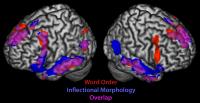By the time Scott Hayner was 7, he had had one skull fracture and three major concussions from falling off horses.
Nobody connected those accidents to the difficulties he had in school. He acted out, stopped talking for three months and cried daily for two years. As an adult, he seemed to be a thriving, successful stockbroker, until traumatic brain injury from a 1999 soccer accident led to seizures and sidelined his ability to talk to people and stay on task, it seemed, for good.
Hope through brain plasticity
Two realizations have turned his life around at 42. First, he realized that brain injuries were behind the troubles he has had all his life. And second, he read about brain plasticity — the concept that the brain can heal and learn at all ages.
"It was a relief," says Hayner, who credits his 2008 training at the University of Texas at Dallas' Center for BrainHealth for helping to restore abilities that he thought were long gone. "It helped me regain my self-esteem and self-confidence. It gave me hope."
Neuroplasticity, or the brain's ability to adapt and change through life, is gaining increased traction in medical circles.
Dr. Norman Doidge, author of the best-selling "The Brain That Changes Itself: Stories of Personal Triumph from the Frontiers of Brain Science" (Penguin, $16), refers to neuroplasticity as "the most important change in our understanding of the brain in four hundred years.
"For the longest time our best and brightest neuroscientists thought of the brain as like a machine, with parts, each performing a single mental function in a single location," he wrote in an e-mail from the University of Toronto (he also teaches at Columbia University). "We thought its circuits were genetically hardwired, and formed, and finalized in childhood."
This meant that doctors assumed they could do little to help those with mental limitations or brain damage, he says — because machines don't grow new parts. The new thinking changes that: "It means that many disorders that we thought can't be treated have to be revisited."
Dr. Jeremy Denning, a neurosurgeon on the Baylor Plano medical staff, has seen that in his own
"The brain has the amazing ability to reorganize itself by forming new connections between brain cells," Denning says. "I have one patient I operated on a year ago who almost died from a hemispheric brain stroke and actually recovered from coma to hemiplegia (paralysis) to actually walking out of the hospital in four to five weeks. There are numerous studies looking at the changes that occur at the molecular level at the site of neuron connections. It is a very complex phenomenon, and we are still in the infancy of completely understanding it."
Lifelong adaptability
Dr. Sandra Chapman believes in lifelong plasticity. As founder of the Center for BrainHealth, she has set several studies in motion to explore how that concept can help those with brain damage and everyone else, including those with aging brains, middle-schoolers who need a brain boost and autistic children who need help rewiring the brain to improve their social cognition.
People such as Hayner have been able to benefit from some of these studies, although BrainHealth is primarily a research institute.
"Our brain is one of the most modifiable parts of our whole body," Chapman says.
That means that just as physical exercise keeps the body healthy, the right kind of learning will make it more likely for our brains to keep up with our ever-expanding life span, she notes.
Even while using the latest high-tech scanning devices to monitor results in her studies, when it comes to brain health, Chapman puts her greatest emphasis on a brain fitness exam that she refers to as a "neck-up checkup." It's done one-on-one using puzzles, paper, pen, pencil and just a few computer questions.
A "brain physical" at the center costs $600. Based on the results, experts recommend a simple, individualized strategy usually focusing on three key areas:
Strategic attention: the skill to block out distractions and focus on what's important. Exercises might include taking stock of your environment, identifying what distracts you and eliminating or limiting them, and creating daily priority lists.
•Integrated reasoning: the ability to find the message or theme in what you are watching, reading or doing. Exercises might include making a point of reflecting on the meaning of a book after you've read it or a movie after you've seen it and writing down your interpretation.
•Innovation: the vision to identify patterns and come up with new ideas, fresh perspectives and multiple solutions to problems. Exercises might include thinking of multiple solutions to problems as they come up, talking to other people to get a different perspective and taking time to step away from a problem to give yourself an opportunity for creative thoughts.
Hayner says his sessions — he attended for two months and completed take-home exercises — proved invaluable.
"I have been on so many drugs and medications, and they got me nowhere," he says. "Adults with TBIs (traumatic brain injuries) tend to become overwhelmed, and when someone becomes overwhelmed, it spirals into fear and chaos, and we have a tendency to shut down.
"Today as long as I stick to what I was taught here about filtering information and innovative thinking and what's important and what's not important and apply that to my real life, things don't confuse and baffle me. … I can make a decision on the important things that have to be done each day."
Things that can strain your brain
•Sleep deprivation
•Multitasking
•Stress
Concussion
•Some medications and sleep aids
•General anesthesia
•Failure to seek help if you notice difficulties such as loss of memory, inability to focus and make decisions, and a struggle to understand.
Source: the Center for BrainHealth









 The invasive implant surgery is not suitable for all patients
The invasive implant surgery is not suitable for all patients